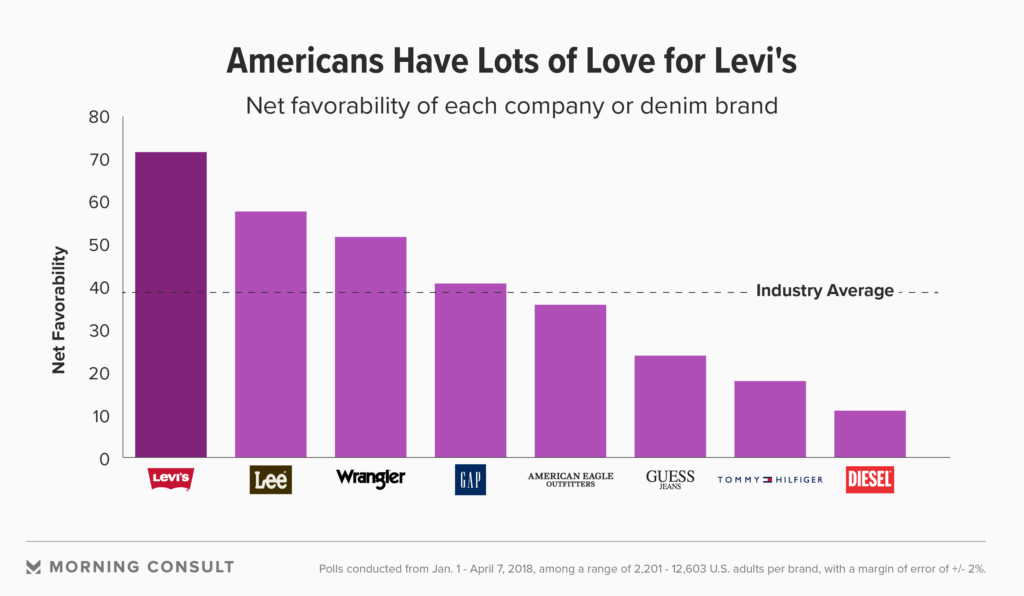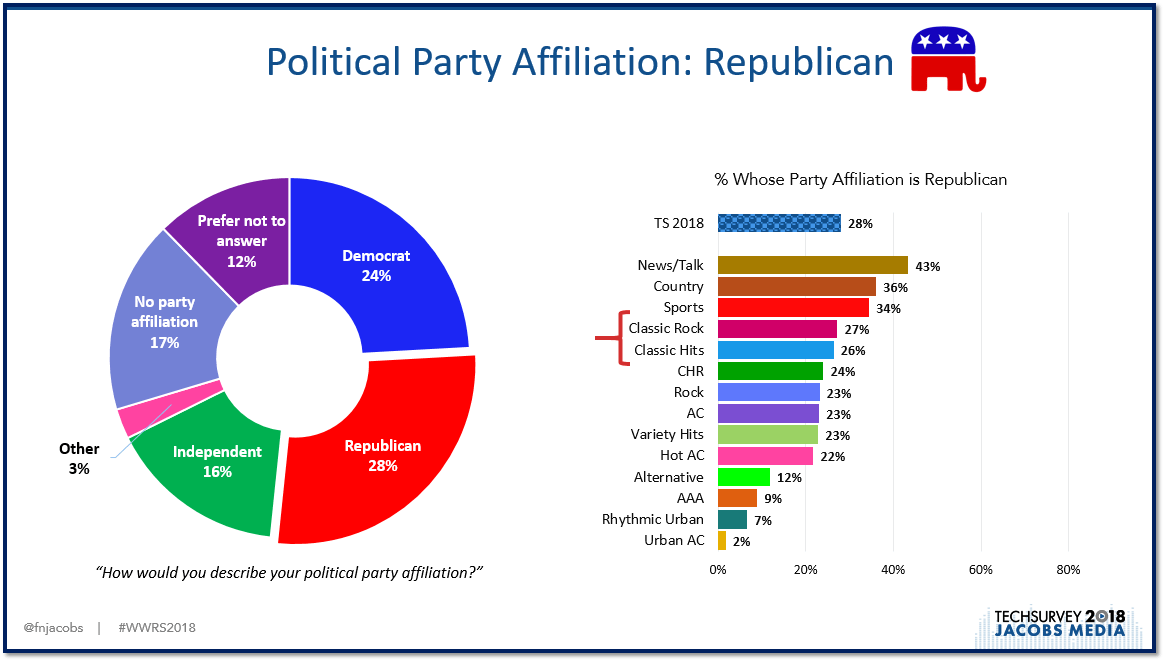Home > Media News >

Source: https://jacobsmedia.com/
There’s a pretty good chance you’re wearing a pair right now.
Blue jeans.
They’ve been around since the 1800s, but it wasn’t until Jacobs Davis and Levi Strauss brought them to the market in 1873 that the style took off. Today, more than half the U.S. wears jeans four or more days each week. And more than a fifth wear jeans every single day.
Like radio listening, jeans have great “reach.” But as heritage radio brands often find out, its easy for even highly-prized, strongly imaged brands to lose their luster. In the case of jeans, they’re still immensely popular. But the growth of the “athleisure” category – stretchy leggings, yoga pants – eclipsed jeans last year.
And for a heritage brand like Levi’s, growth has been elusive. It’s certainly not for lack of image. A great analysis in Morning Consult – “Rebuilding the Levi’s Brand” – take a close look at the blue jean industry, and the parallels to radio brands are obvious. In Levi’s case, writer Joanna Piacenza reports Levi’s image is pristine. Like Harley-Davidson, there’s a lot of love and nostalgia for Levi’s. But that doesn’t mean sales in 2018 are worth bragging about, as it’s easy take a brand like Levi’s – or your Classic Rock station – for granted.

This poll taken earlier this year clearly shows a sizable image advantage for Levi’s over its competitors. But like once popular radio stations that have “been around a long time,” being loved and being listened to (or purchased) are often too different things.
Like great heritage radio stations, Levi’s are dependable, they’ve been around forever, they’re built to last, they’re familiar, and they conjure up great memories. All that said, it’s easy for consumers to simply overlook a cultural icon they’ve used for decades.
Piacenza’s analysis is a solid read, revealing seven key lessons heritage radio brands can learn from Levi’s travails:
1. Lean into nostalgia, while you innovate
There’s nothing wrong with playing the heritage card. As I’m writing this post, WMMR/Philadelphia is in the midst of their 50th birthday celebration.
Thats all well and good, but the station continues to launch new events, as well as digital assets from Alexa skills to daily videos to podcasts.
It’s important to remind your key customers they grew up with you, but they also need a reason to stay with the brand over the decades.
2. Reinvent, reinvent, and then revinent some more
Christian D. Bruun authored “Blue Gold: American Jeans,” a book that tells the history of jeans. He admits that while it’s not as simple as it sounds, a heritage platform has “to revinvent the same thing over and over and over again.” Programmers of gold-based stations are tasked with that same challenge. That’s how special weekends, carefully planned stunts, and other topical music applications can help reshuffle the deck – especially when you’re dealing with a finite music library – or clothing like blue jeans.
3. Expand the demos (when you can)
Talk to the smartest Classic Rock programmers, and they’ll tell you a key to their success isn’t just pleasing their target male demographic – it’s about making the statin appealing to women, too. Interestingly, that’s the same dynamic in the world of jeans. Adheer Behulkar with consultant firm A.T. Kearney Inc. says it’s simple: “If you lose women, the whole category tends to suffer.” While they may not wear jeans as often as their male counterparts, female consumption – of Levi’s and Classsic Rock – is a linchpin that separates success from mediocrity.
4. Don’t get stagnant
In the jeans industry, nothing much has changed for a looong time from the standpoint of fashion. On the other hand, the aformentioned athleisure wear space has exploded. And all the while, jeans are…well, jeans. The last big trend for Levi’s was skinnny jeans, and that was quite some time ago. You have to modernize even a very mature category like denim to stay fresh and vital. Some heritage stations have found ways to keep it fresh by carefully stretching format boundaries, bringing fresh talent to the airwaves, and launching promotions that are new and different.
Jim Ryan did just that at WCBS-FM/New York when he hired Scott Shannon for mornings, while updating the stations music to the ’80s rather than its Beach Boy image. At the Worldwide Radio Summit, Jim was on a panel called “Great Brands Do What Others Simply Won’t Or Cannot Do,” moderated by Lori Lewis. He explained the critical importance of heritage radio stations transforming themselves in order to survive…and thrive.
Audiences of heritage brands have expectations – but it’s not just about hearing the same collection of songs it plays. For WCBS-FM, it’s still about entertainment and fun, even though the brand has been compeltely “redecorated.”
5. Don’t rest on your laurels
You get the pattern here. It’s easy for radio brands that have been around for decades to mail it in now and again. Great programmers and managers push their heritage staffs to change it up and continue being famous for new things. You may be playing music that’s decades old, but that doesn’t mean it has to sound dated or tired.
6. Don’t assume you know your brand’s audience
That’s because even though your brand may stand for the same basic values over time, your following can change. Perhaps you’r surprised to learn Republicans are considerably more likely to wear jeans than Democrats. That fun fact about the Levi’s target may have familiar ring to it for radio programmers.
This year’s Techsurvey also asked our 64,000+ respondents about their political leanings. While Classic Rock may have its roots in the liberal, hippie protest movemenets and concert festivals that defined the ’60s, today they’re more likely to embrace the party of Donald Trump, Mitch McConnell and Paul Ryan.

Understanding how your audience is changing – even if you aren’t – is part of the process of nurturing and growing a vital, breathing brand.
7. Embrace technology
For its pricey Authorized Vintage line, Levi’s relied on manual finishing of its jeans that gave them the broken-in look. But earlier this year, the commpany revealed it was moving to lasers to achieve the same effect. That’s analogous to heritage stations keeping up with technology trends to keep it fresh and to also speak to younger audiences.
It’s why our Techsurvey tracks formats, rather than generic audience trends. This allows programmers of adult formats to better understand how their audience interfaces with technology. Classic Rock stations should be launching Amazon Echo skills, News/Talk managers should be building apps with push notifications, and why AC programmers ought to be posting shareable videos of the morning show.
Levi’s has learned a lot of these lessons the hard way, experiencing a roller coaster ride of sales and financial performance. Great radio brands shouldn’t have to suffer the same turbulent fate.
It starts with hiring great programmers who not only act as brand stewards, but also view their responsibility as modernizing and growing their station to keep up with – and even ahead of – the times.
Like an old pair of jeans, a heritage radio station should feel comfortable.
But they should still make you feel cool.
Right Now
Top Stories










